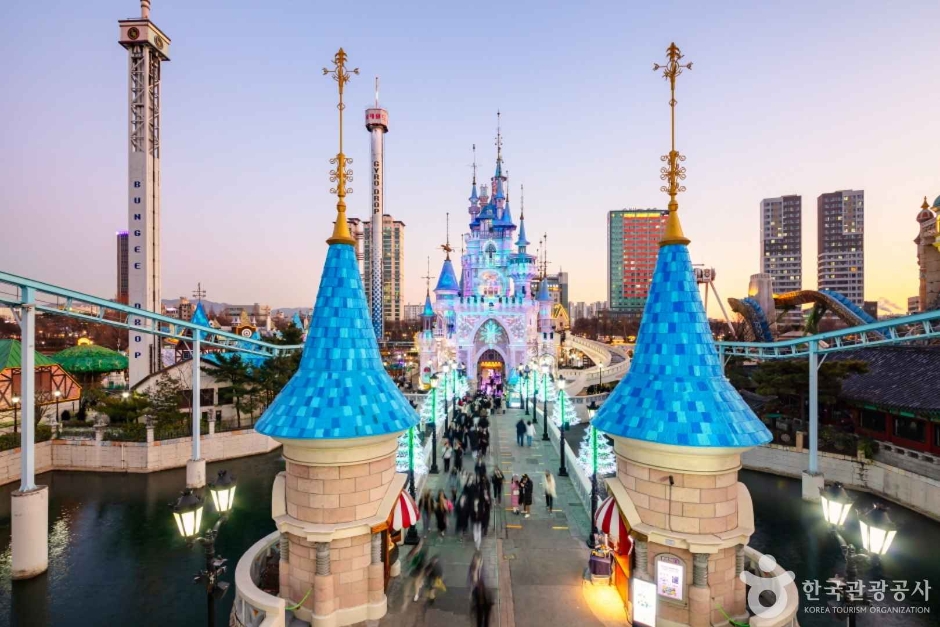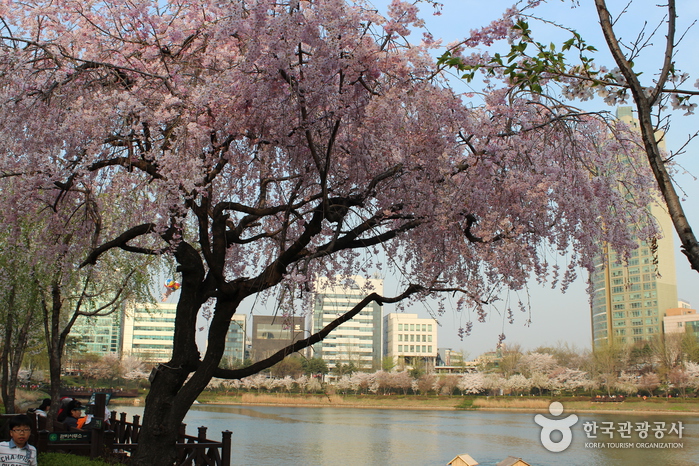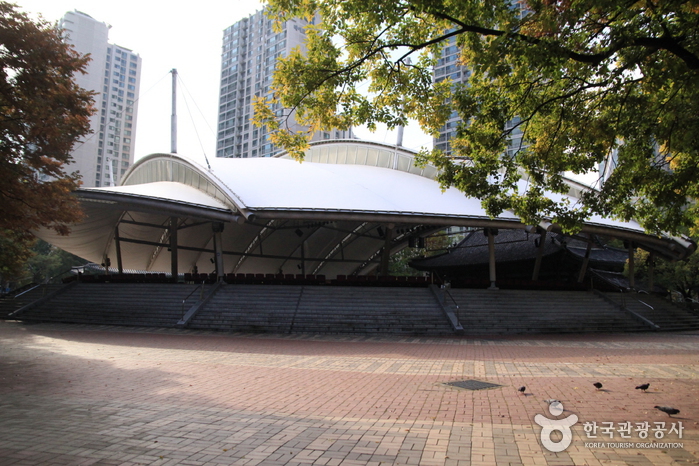Lotte World(롯데월드 어드벤처)
5.1Km 2025-06-10
240 Olympic-ro, Songpa-gu, Seoul
+82-1661-2000
Operated by Lotte Group, Lotte World is the perfect spot for entertainment and sightseeing for Koreans and international tourists alike. The theme park is divided into the indoor Lotte World Adventure, and the outdoor lakeside Magic Island, with additional amenities including a shopping mall, folk museum, ice rink, hotel, and more.
Lotte World Adventure is the world's largest indoor amusement park, complete with top-of-the-line rides, fantastic parades and performances, and food from around the world. The Folk Museum displays miniature models of Korea throughout 5,000 years in history. Lotte World Garden Stage presents various themed musicals to match each season and Lotte World Star Avenue is the perfect place to experience Korean stars and the entertainment world.
Lotte World Folk Museum (롯데월드 민속박물관)
5.1Km 2024-03-12
240, Olympic-ro, Songpa-gu, Seoul
+82-2-411-4762
Lotte World Folk Museum, located within Lotte World, is a museum showcasing the ancient lifestyles of Korea. It exhibits artifacts from the prehistoric era to the Japanese colonial period, divided by historical eras. Particularly noteworthy is the miniature village, featuring over two thousand dolls at a scale of 1:8, depicting various aspects of life during the Joseon dynasty, including the four seasons, seasonal customs, four ceremonial occasions, and the lives of the yangban and commoners with remarkable realism.
Charlotte Theater (샤롯데씨어터)
5.1Km 2024-03-20
240 Olympic-ro, Songpa-gu, Seoul
The Charlotte Theater, located near Lotte Tower in Jamsil, features an elegant and luxurious interior and exterior reminiscent of medieval Europe, providing a sophisticated setting for musical performances. With a short distance between the stage and the audience, spectators can vividly experience the actors' performances up close. It hosts productions such as The Phantom of the Opera and Jekyll & Hyde.
KidZania Seoul (키자니아 서울)
5.1Km 2024-03-13
240, Olympic-ro, Songpa-gu, Seoul
+82-1544-5110
KidZania is a theme park organized around the idea of vocational experience for children. It is home to a variety of facilities where one can experience different career paths, all located on a scale model of a city. Visitors can learn what it is like to work as a firefighter, doctor, cook, member of the police force, reporter, and more.
Agurang Kkotgerang (아구랑꽃게랑)
5.1Km 2024-03-08
35-7, Dongho-ro 24-gil, Jung-gu, Seoul
+82-2-2263-5554
This is a seafood restaurant specializing in Ganjanggejang (Soy sauce marinated crab). The crab is plump and seasoned to perfection, making it an excellent accompaniment to steamed rice. The restaurant’s Gulgukbap (Oyster and rice soup), a winter favorite, is enhanced with seaweed fulvescens, which is rich in vitamins and iron, making it beneficial for those suffering from anemia. Side dishes include Cheongpomukmuchim (Mung bean jelly salad), Kimchi, and Kongnamulmuchim (Bean sprout salad). Another popular item on the menu is the spicy Agutang (Monkfish soup), filled with springy monkfish.
Song Won (송원)
5.1Km 2024-03-15
35-4 Dongho-ro 24-gil, Jung-gu, Seoul
+82-2-2275-3118
Song won is a Korean restaurant located in Jangchung-dong Gourmand Alley. They specialize in high-quality Korean beef barbecue such as bulgogi and galbi, seasoned with a variety of 20 different natural ingredients. Additionally, they offer traditional Korean dishes like hot stone pot rice and noodles. Across the street, visitors can find Jangchung-dong Jokbal Street, and both Jangchungdan Park and Jangchung Gymnasium are within walking distance.
Rodeo Eyewear - Seorae Village Branch [Tax Refund Shop] (로데오안경 서래마을)
5.1Km 2024-04-18
1F, 44, Seorae-ro, Seocho-gu, Seoul
-
Songpa Naru Park (Seokchonhosu Lake) (송파나루공원 (석촌호수))
5.2Km 2025-10-23
136 Samhaksa-ro, Songpa-gu, Seoul
Songpa Naru Park, also commonly referred to as Seokchonhosu Lake, is a citizen park in Seoul with a jogging course and walking trails. It has two lakes with Songpa-daero Boulevard running in between. Originally, a branch of the Hangang River ran through the site, forming one large lake, but the lake was divided into two with the construction of Songpa-daero Boulevard. The total size of the two lakes is 217,850 ㎡, and they hold about 737 tons of water. The depth of the lakes is 4-5 meters.
Seoul Nori Madang (서울놀이마당)
5.2Km 2021-02-10
136, Samhaksa-ro, Songpa-gu, Seoul
+82-2-2147-2800
Established on December 25, 1984, Seoul Nori Madang offers diverse traditional performances on an outdoor stage to promote Korean folk plays and culture. Performances are regularly held every weekend; it hosts over 120 performances every year and each performance attracts over 1,300 visitors. Within Seoul Nori Madang is Songpa Folk Preservation Association, which offers seminars on folk plays such as Songpa Sandae Nori and Songpa Baekjung Nori for students, free of charge.
Gwanghuimun Gate (광희문)
5.2Km 2021-02-24
344, Toegye-ro, Jung-gu, Seoul
+82-2-3700-3900
Gwanghuimun Gate is said to have been originally constructed in 1396, the 5th year of King Taejo, at the southeast of the capital city. It was often referred to as Sugumun Gate (water channel gate) and was actually used as a Sigumun, literally meaning “corpse gate,” as funeral processions passed through this gate when exiting to the east.
During the Imjin War (1592-1598), the fortress gate was destroyed to such a degree that it made finding the original location close to impossible. Nevertheless, reconstruction efforts were started in 1711 (37th year of King Sukjong) and the gate was restored together with the gate's watchtower. Gwanghuimun Gate remained intact even when the fortress walls were demolished to build tram tracks during the Japanese occupation, but it was later damaged during the Korean War and left neglected. In 1975, restoration work was carried out to relocate Gwanghuimun Gate to a site 15 meters south of its original location since it stood in the middle of the road.




![Rodeo Eyewear - Seorae Village Branch [Tax Refund Shop] (로데오안경 서래마을)](http://tong.visitkorea.or.kr/cms/resource/93/2889293_image2_1.jpg)



 English
English
 한국어
한국어 日本語
日本語 中文(简体)
中文(简体) Deutsch
Deutsch Français
Français Español
Español Русский
Русский